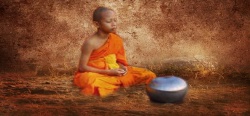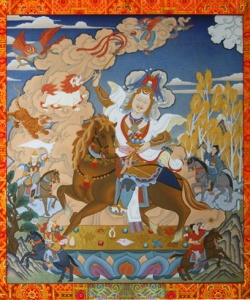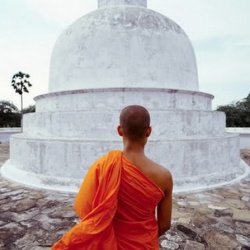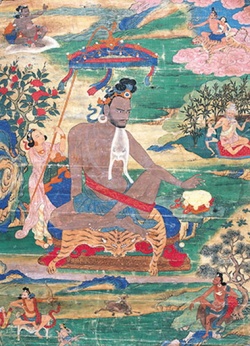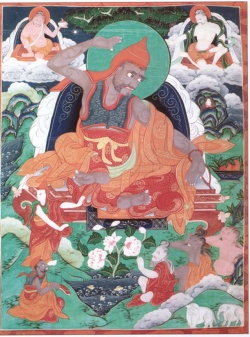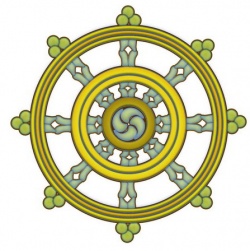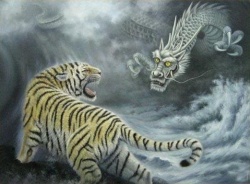Great Shambhala
The Tibetan people have many stories about the kingdom of Shambhala, where the mystical Kulika kings ruled. No doubt there is a spiritual component to Shambhala which transcends any historical reality, which we shall not explore. What is of interest for this work is the actual physical kingdom that was the basis for the historical accounts of Shambhala, which is also rendered Shamballah, Sambala, Shamballa, etc. The core of our argument lies in the identification of Shambhala as the source of the Buddhist tantric doctrine known as Kalachakra. The Kalachakra tantra is central to Tibetan Buddhism. However, it wasn't the first form of Buddhism brought to the country. It arrived only around the 11th century from India. The Kalachakra, or at least the developed form of the doctrine, came less than a century earlier to India from Shambhala. Tradition says that the Buddha first conveyed the Kalachakra dharma to the Shambhala king Sucandra at a stupa in the southern Indian state of Andhra Pradesh. From there it was brought by the king back to Shambhala and preserved there, and only there, until its return to India in the 11th century.
A close examination of Tibetan history concerning the origin of the Kalachakra is somewhat divergent. One version credits the Indian holy man Tsilupa with bringing the doctrine from Shambhala to India in 966 or 967 AD. This is known in Tibet and Nepal as the Rva Tradition. The opposing version is known as the Dro Tradition and it credits the Shambhala king Sripala with bringing the Kalachakra to India at about the same time mentioned in Rva Tradition. The Tibetan scholar Geshe Lhundub Sopa theorizes that the Shambhala king Sripala may have been from the area known in Indian texts as Suvarnadvipa1. He notes that Sripala is said to have been from the "southern ocean," which in Indian geography refers to the eastern Indian Ocean and South China Sea. Suvarnadvipa was the Indian term for what we know today as insular Southeast Asia. Sopa's theory is not all that far-fetched when one considers that when the great Indian guru Atisha visited Suvarnadvipa, he found the Kalachakra Tantra already well established there. Inscriptions and artifacts from insular Southeast Asia verify the presence of Kalachakra doctrine in the region although they don't tell us exactly when they first appeared there. The Kalachakra Tantra is always found within the context of Vajrayana Buddhism and we know this form of Buddhism flourished in the region for centuries before Atisha's time. The idea of the Shambhala king Sripala, also known as Kalki Sripala as he belonged to the Kalki or Kulika lineage, hailing from the Southern Ocean is supported by traditions popular in Tibet.
The traveller Nicholas Roerich mentions these traditions that place Shambhala "far beyond the ocean."
Another view, especially popular in the West is that Shambhala is located somewhere to the north of Tibet. These views seem to stem mainly from passages in Tibetan texts that mention Shambhala as located north of the river Sita, or that state travel to the region started by going in a northern direction. Those who place Shambhala to the north equate the Sita with some river to the north, usually the Jaxartes in present-day Xinjiang. However, there is also a very strong argument for the river Sita being located to the east of India. The Sita is often said to run through the island known in Indian texts as Sakadvipa. A number of important sources state quite explicitely that Sakadvipa is located to the east of India2. Futhermore, they give an idea of a tropical location lush with tropical flora and fauna. The idea of traveling north to reach Shambhala need not be problematic if one considers that most of the ancient itineraries to this destination mentions several changes of direction on the way to the fabled kingdom. Including in some of these guidebooks is the mention of voyages across the ocean. The early texts that mention voyages to Shambhala tell of students and pilgrims who stay there for prolonged periods of time before returning to Tibet. They no doubt spoke of a real rather than a mythical place. In latter texts, the voyages become rare and more fantastic in nature. They tend to appear only in texts not written in a historical fashion. At some point, it appears that the real voyages to Shambhala ceased for some reason. However, during the period of historical contact we know that a direct southern route to Suvarnadvipa would have probably been more difficult than taking the Silk Road to the north. From there one could take a ship from ports on the East Asian coast particularly off South China. We know that this was the route taken by many European travellers during the 13th and 14th centuries including Marco Polo. There is one strong argument for a northern location though -- the mention of the snow-capped mountains around the capital of Shambhala. We will deal with this problem in the conclusion when we offer a theory on a more precise location for the kingdom.
A tropical paradise?
In contrast to the mention of snow mountains, there are indications of a southern location for Shambhala as well. There is a garden there known as Malaya, which is lush with tropical vegetation including sandalwood trees. Of course, the word "malaya" or "malay" is a common placename in insular Southeast Asia. Some sources tell of visitors to Shambhala returning with mangoes or other tropical products. The many points of coincidence between Shambhala and the descriptions of the kingdom of Prester John also allow us to look toward a tropical location in the "Indies." The most important document concerning the historical Prester John is the letter from that fabled monarch to the the kings of Europe including the Byzantine and Holy Roman Emperor. While it is popular these days to dismiss the letter as a hoax, there is a strong argument of authenticity as well. We will discuss this in the section on Prester John's kingdom. If we accept the description given in Prester John's letter, we first note that he claims his kingdom extends over the "Three Indias." The idea of Three Indias first appears in Europe in the Ravenna Cosmography which was written in the 7th or 8th century. The concept conforms to that of the Islamic view of the three Indies -- Hind, Sind and Zanj. These were known respectively in Europe as India Major, extending from Malabar to India extra Gangem (East Indies), India Minor, from Malabar to Sind, and India Tertia, the coast of East Africa, specifically the Tanzania region to the Muslims (Zanj). The idea of a Central Asian or Siberian region as part of the the "Three Indias" was not found at this time, so we can see the southern direction of the kingdom of Prester John There a number of interesting correspondences between the kingdoms of Prester John and Shambhala, which are listed below:
Prester John was a priest king. The ruler of Shambhala was a king and lama. A lama is a religious teacher whose duties cover those of the priest in the Western church. Both kings were described as emperors ruling over a large number of subject kingdoms. The Shambhala king ruled over 96 minor kings, while Prester John was said to have 72 subject sovereigns.Kings from both regions are said to be involved in a future dualistic "final battle" that would usher in a golden age. The 25th Shambhala king is prophesied to fight in a future battle against a "barbarian" people known as the Lalos. In Prester John's letter he mentions that he controls the nations of Gog and Magog which will be loosed in the endtimes to ravage the world including Rome. After an alliance of 15 nations led by Gog and Magog are defeated, the letter speaks of a descendant of Prester John victoriously rescuing Europe:"These accursed fifteen nations will burst forth from the four quarters of the earth at the end of the world, in the times of Antichrist, and overrun all the abodes of the Saints as well as the great city Rome, which, by the way, we are prepared to give to our son who will be born, along with all Italy, Germany, the two Gauls, Britain and Scotland. We shall also give him Spain and all the land as far as the icy sea. The nations to which I have alluded, according to the words of the prophet, shall not stand in the judgment, on account of their offensive practices, but will be consumed to ashes by a fire which will fall on them from heaven."
An account related in the Chronicle of Otto, Bishop of Freising in 1145 appears to allude to a passage in the Book of Revelation that tells of the drying of the Euphrates River to open the "way of the Kings of the East." The chronicle states that Prester John was attempting to make his way to rescue Jerusalem. Each kingdom was associated with a lens or mirror that allowed the king or other user to see everything that was happening throughout the realm3. The idea of a sacred talismanic stone: the cintamani in Shambhala, and the Holy Grail stone of Parzival. Another legend states that among the gifts sent by Prester John to the Holy Roman Emperor included the Philosopher's Stone. In Tibetan and Mongolian traditions, Shambhala is associated with subterranean tunnels and caves. In the letter of Prester John, there is an interesting comment for comparison: "Near the wilderness trickles between barren mountains a subterranean rill, which can only by chance be reached, for only occasionally the earth gapes, and he who would descend must do it with precipitation, ere the earth closes again."
Each kingdom is described as "Fortunate Isles" in terms of natural abundance and fertility. Shambhala is one of the Buddhist "purelands" where people of good karma are reborn and live happily and virtuously. The kingdom of Prester John is likewise blessed and contains nothing less than the original Garden of Eden. The people live virtuously as stated in the king's letter: "With us no one lies, for he who speaks a lie is thenceforth regarded as dead ; he is no more thought of, or honored by us. No vice is tolerated by us." Both regions are known for their tamed elephants, another clue pointing toward the "Indies." What is equally of interest is the fact that we first hear of Prester John's kingdom in Europe about a century after the Kalachakra begins to spread to India and Tibet.
Land of Pilgrimages
From the historical perspective, Shambhala is a real land from whence the Kalachakra came to India and Tibet. The only candidate that we know of that could fit the bill is Suvarnadvipa. However, Shambhala continued to be an important destination for pilgrims and students long afterward. Tibetan annals not only describe, in a matter-of-fact fashion, Tibetans going to visit, stay and return from Shambhala, but likewise visitors from Shambhala are said to come regularly to Tibet! so we know for sure that there was a period of historical contact between the two regions. Insular Southeast Asia again fits the bill here and better than any region in the world. During the relevant centuries, the region was the premier learning center in the world of Buddhism. As early as the 7th century, we hear from the Chinese pilgrim I-Ching about a place in insular Southeast Asia known as Foshi. I-Ching wrote that at Foshi "the level of the sciences has reached such a state, that one can say all the knowledge of the world flows from this island4." He recommended that Buddhist scholars from China should first come to Foshi and stay for a year or two before going to India. In the early 11th century as already mentioned, the great Indian scholar Atisha came to study under the Buddhist master teacher of Suvarnadvipa known as Serlingpa or Dharmakirti. We also learn that the inhabitants of Suvarnadvipa were also interested in traveling and promoting Buddhism in far-off places. Kings and scholars from this region ventured into India and donated monasteries and other gifts particularly in the 10th and 11th centuries. So Suvarnadvipa in the "southern ocean" fits very well when we consider that Shambhala was also know as a great place of pilgrimage that sent its own pilgrims as well. It was likely the home of King Sripala who came from the same ocean and is credited in the Dro Tradition with bringing the Kalachakra to India. Footnotes
1 Geshe Lhundub Sopa, Roger Jackson, John Newman, Beth Simon. The Wheel of Time: The Kalachakra in Context. Snow Lion Publications, 1991
2 Mahabharata XII.14.23. See also Brihat Parasara Horasasta.
3 See Edwin Bernbaum. The Way to Shambhala. Random House, Inc. 2001; Mipham, Commentary on the Shambhala sections of the Kalachakra Tantra; and Wolfram von Eschenbach's Parzival.
4 Hui-li. The life of Hiuen-Tsiang. Westport, Conn., Hyperion Press, 1973.
